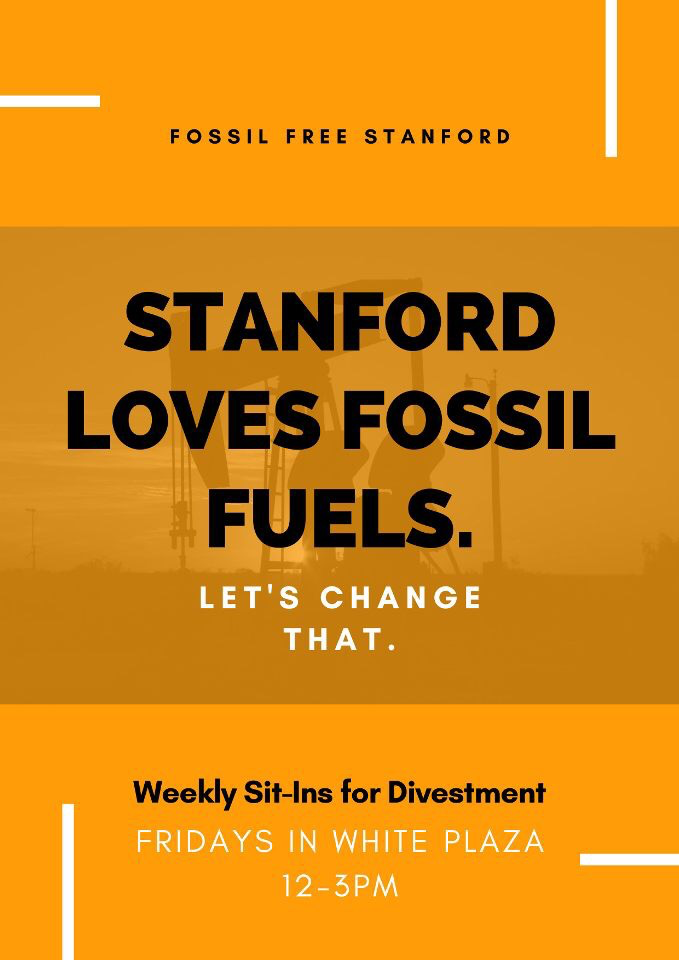Last month, the University of California (UC) system announced that it would eliminate all fossil fuel investments from its $13.4 billion endowment and $70 billion pension fund by 2020. This move coincided with increased coverage of climate-related disasters and the well-publicized surge in global youth activism in the past year. The UCs have demonstrated to all other schools that this critical institutional step to mitigate the climate crisis is feasible; their decision is, according to author and 350.org founder Bill Mckibben, “the biggest single commitment by any educational institution in the world and represents a true watershed.” So the glaring question emerges: When will Stanford follow suit?
Stanford students, organized through Fossil Free Stanford, have been pushing for full fossil fuel divestment for nearly eight years. In 2014, Stanford divested from the coal industry, but still continues to invest in oil and gas. Last year, Fossil Free Stanford submitted a report urging the University to divest but still has not received a response. Fossil Free currently demands that Stanford commit to total divestment by Earth Day 2020. Every day Stanford postpones divestment is another day that it remains a complacent institution in a sea of widespread climate inaction and fails to contribute momentum to desperately needed climate solutions. Given the urgency of this matter and the university’s continued silence, it’s now up to students to hold the University accountable for protecting our futures and doing what’s right. We must add to Fossil Free’s growing momentum and bring the issue of divestment to the forefront to make it as difficult as possible for Stanford to ignore our demands.
Stanford’s mission statement states that it strives to “promote the public welfare by exercising an influence on behalf of humanity and civilization.” Additionally, Stanford’s Board of Trustees recently stated, “As a research and educational institution with a deep commitment to addressing pressing global challenges, Stanford has embraced sustainability practices and demonstrated leadership in how it operates the university.” However, its retention of fossil fuel investments is hypocritical because it demonstrates a failure to lead in that arena of sustainability. Additionally, it distinctly fails to promote the welfare of humanity — including that of its own students. Climate change presents societal disruption unparalleled in human history, and its worst effects are already harming the world’s most marginalized communities and will disproportionately impact today’s youth. How can Stanford claim to promote public welfare if it can’t fully do its part in preventing the global issues most threatening to its students?
Furthermore, Stanford stands to gain from divestment because the fossil fuel industry’s profitability is declining. According to the UC’s chief investment officer Jagdeep Singh Bachher, “hanging onto fossil fuel assets is a financial risk.” The growing renewable energy sector, on the other hand, is an increasingly financially promising alternative. According to the International Renewable Energy Agency, the cost of all commercially used renewable energy sources will be directly competitive with fossil fuels by 2020. As Baccher recognized, renewable energy technologies represent “more attractive investment opportunities.” Renewable energy is our future, and fossil fuels are becoming a remnant of our past.
Stanford has far-reaching influence as a leader in research and undergraduate teaching, but it must demonstrate that it can actually live up to this role. Not only is divestment the bare minimum the University can do to show commitment to climate action, it represents an opportunity for Stanford to contribute critical momentum to the divestment movement and stand as an inspiration to other colleges and universities. At this important moment, student’s actions have the potential to influence institutional change that can only have ripple effects nationwide.
If Stanford is truly the hub for innovation it claims to be, why is it so slow to invest in the future of energy technologies instead of the soon-to-be outdated fossil fuel industry? It’s time for us to compel Stanford to choose whether it will do its part to prevent the worst potential path of climate disaster, or if it will instead fail to live up to the vision of leadership and innovation it strives to embody.
We must also urge Stanford to show us — not tell us — that they will prioritize what students want. According to the 2018 ASSU spring ballot, 83% of the undergrad population and 78% of the graduate population favored divestment. Although this by itself should make the case for divestment, we must do more than publicize student opinion to get Stanford to actually listen and respond to our priorities and demands.
It’s time for students to unite together and amplify the divestment demand as forcefully and constantly as we possibly can. As a first step, Fossil Free Stanford is organizing sit-ins every Friday at White Plaza from 12 to 3 p.m. in order to increase awareness and involvement throughout the campus community. Everyone is invited, and there will be sign-making, snacks, and conversation about continued organizing strategies.
We must embrace Fossil Free Stanford’s call to action and pressure Stanford to fully divest from oil and gas stocks. We must demand that the University not delay this inevitable shift in their divestment portfolio. We must ensure that the University enacts its promise to its students and humanity at large. Stanford not only can — but must — harness its extensive power and sterling reputation to propel climate solutions forward.
Contact Sophia Manolis at smanolis ‘at’ stanford.edu.
